Today, let’s discover a world of fruits that start with the letter J. While many of the fruits beginning with this letter may not be as commonly known as others, they still possess a distinctive charm that deserves our attention. In this article, we will uncover a diverse selection of over 14 fruits, each with its own unique flavors, textures, and intriguing characteristics. From the familiar to the more exotic, let’s get to know the 14+ fruits that start with the letter J!
1. Jaboticaba
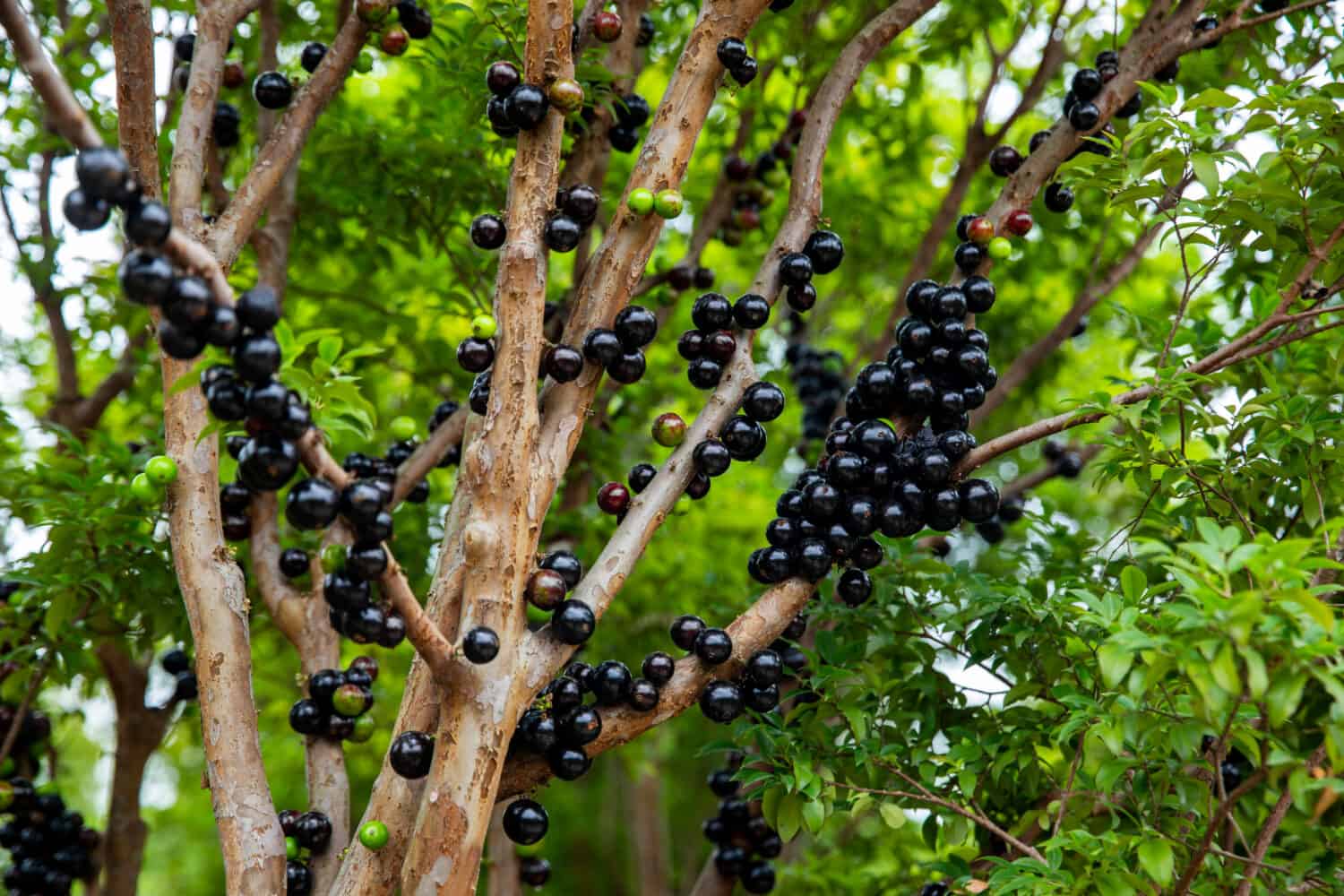
Due to its short shelf life, jaboticaba is only available in certain areas of the world.
©litchima/Shutterstock.com
Jaboticaba is a unique fruit that grows in small clusters all over the branches of the jaboticaba tree. Its scientific name is Plinia cauliflora, and it is also referred to as Brazilian purple grapes. The fruit is native to Brazil, Paraguay, Peru, and Argentina and is similar in size and appearance to grapes.
This fruit has a short shelf life (only 3 days after harvest), so it is only available in the areas of its cultivation. Its taste is also similar to grapes, a blend of sweetness and tanginess. It has a thick outer skin that is perfect for medicinal purposes. Under its edible skin lies a gelatinous fleshy goodness and 1 to 4 seeds.
The jaboticaba is mostly eaten fresh, but it is also used to make jams, jellies, wine, and desserts. It is a tasty fruit, and although it comes in a small package, it is filled with nutrients like potassium, calcium, phosphorus, and vitamins A, C, and E. All these health benefits make it a beautiful and healthy addition to any diet.
2. Jackfruit
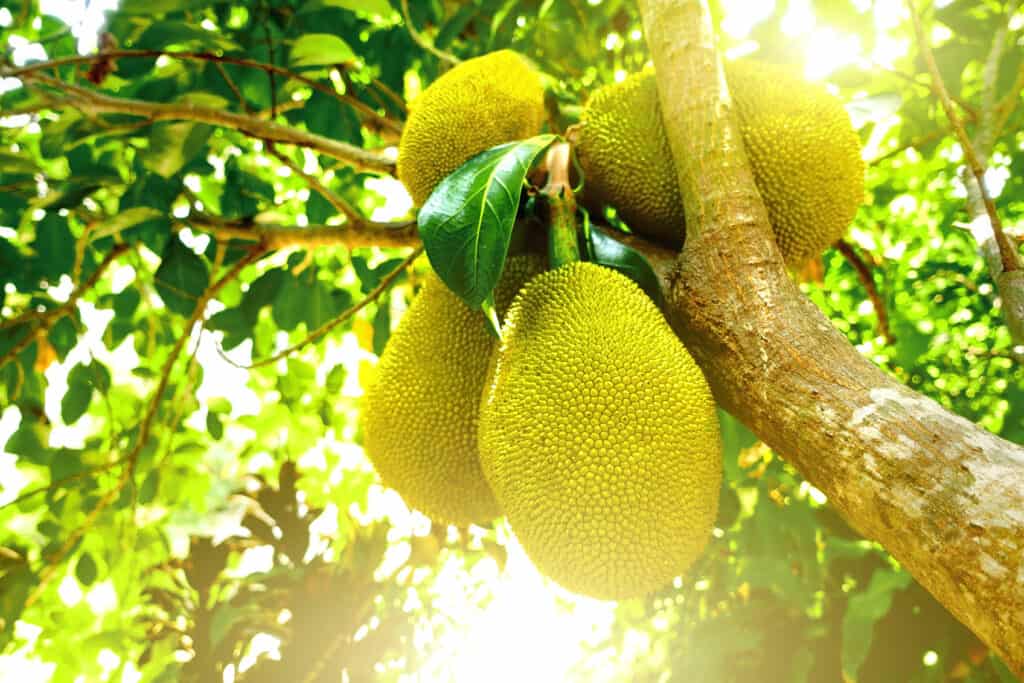
Probably the most famous fruit that starts with J is the jackfruit.
©ChockdeePermploysiri/Shutterstock.com
Jackfruit is a popular high-fiber fruit cultivated and consumed in many parts of the world. Its scientific name is Artocarpus heterophyllus. This fruit is the largest fruit to grow on a tree, with some species weighing up to 80 pounds in some cases! In fact, the heaviest jackfruit, securing a Guinness world record, weighed a whopping 42.72 kilograms (94 lb 2.9 oz), produced in Pune, India.
Jackfruit is consumed in both ripe and unripe stages. When ripe, it has a sweet flavor and is a perfect ingredient for many desserts. An unripe jackfruit has an almost meaty texture and is often a meat substitute in vegetarian or vegan dishes like curry, nuggets, cutlets, and stews.
Jackfruit is a highly versatile fruit, and each part of it, including seeds and leaves, is edible and consumed in diverse ways. This fruit has a high fiber content and protein and is rich in vitamins C, B, and potassium.
3. Jujube
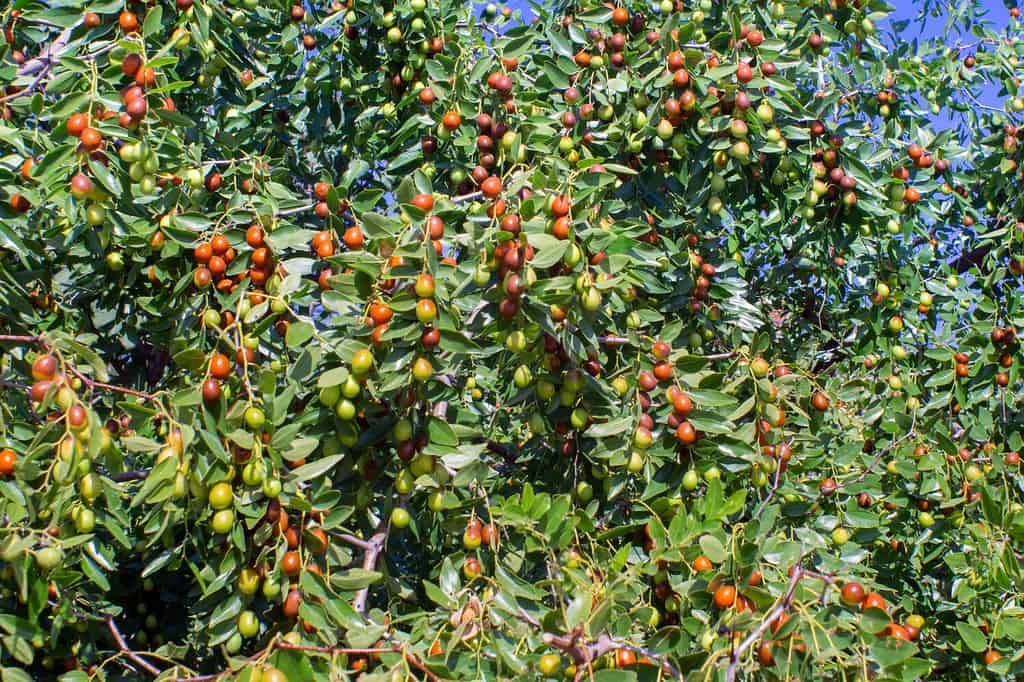
Consumed fresh or as dried fruit, the jujube is rich in vitamin C.
©darksoul72/Shutterstock.com
Jujube, popularly known as red date or Chinese date, is another exciting fruit starting with the letter J. Its scientific name is Ziziphus jujuba. This is a widely cultivated plant as it can withstand various temperatures. Although this plant requires hot summers, it can survive temperatures below freezing, up to 5 degrees Fahrenheit!
You can eat jujube as both fresh and dried fruit. In fact, it is more popular as a dried fruit. It is also used to make marmalades, candies, and juices. Jujube is also used to produce a traditional Asian beverage with lotus seeds, barley, and other ingredients.
This fruit is also rich in nutrition, especially vitamin C. Due to its high vitamin C content, it is a natural anti-aging and immunity booster superfood.
4. Juniper Berry

Due to its strong taste, juniper berries are often used to add flavor.
©Michelle Lee Photography/Shutterstock.com
Juniper berries are small, blue-black fruits that grow on evergreen shrubs of the Juniperus genus. Although it is referred to as a berry, it is actually a seed cone with a berry-like appearance. This fruit has a distinct flavor profile, often described as woody, piney, and slightly tart. Juniper berries are known for their intense aromatic properties.
This fruit is mostly used as a spice to add flavor to dishes and beverages, including gin. They pair well with ingredients like venison, lamb, and duck, giving them a unique and robust flavor.
Apart from its strong taste, the juniper berry also has high antioxidant and anti-inflammatory properties.
5. Jambul

The seed and fruit of the jambul are helpful against diabetes.
©SMDSS/Shutterstock.com
Jambul, also known as java plum or jaman, is a small fruit native to Pakistan, India, Sri Lanka, and other countries of South Asia. Its scientific name is Syzygium cumini.
This fruit has dark purple to blackish skin and a juicy sweet, tangy, and somewhat spicy flavor. Interestingly, if you eat this fruit, it will also leave its color on your tongue along with a lingering taste. Jambul is commonly eaten as a fresh fruit.
The seed of the jambul fruit holds tremendous medicinal properties in Ayurveda and Unani medicine. Some sources claim that the fruit and its seed has miraculous effect against diabetes.
6. Japanese Persimmon
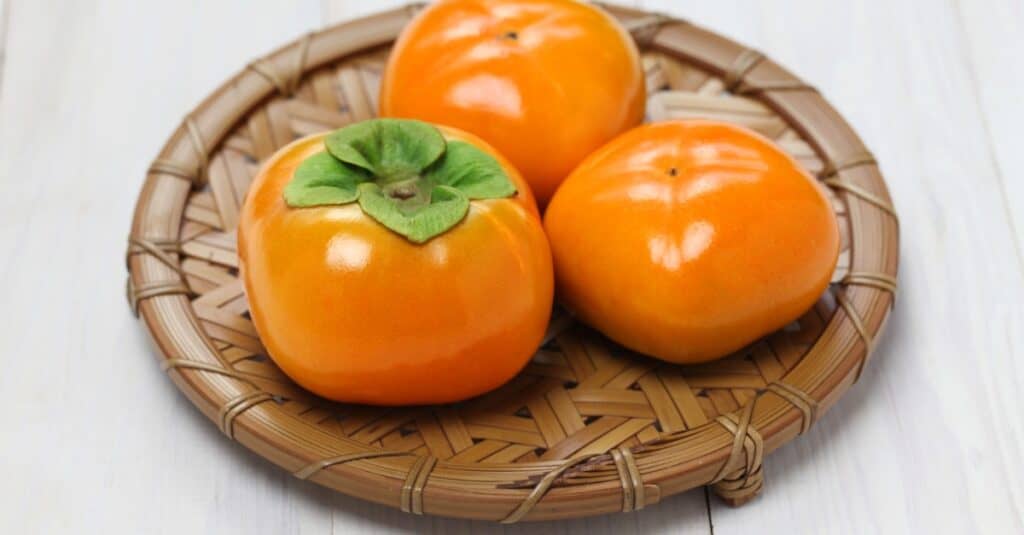
The Japanese persimmon comes from East Asia, and you can eat it either fresh or cooked.
©iStock.com/bonchan
Japanese persimmon, known as Diospyros kaki, is a delightful fruit from East Asia. With its round shape and vibrant orange color, it is a visual delight. When fully ripe, the fruit has smooth skin and a sweet, honey-like flavor. However, the unripe fruit tastes bitter due to its high tannin content.
This fruit can be eaten fresh, added to salads, or used in baking and desserts. Its leaves are traditionally used in Japan to make tea.
Japanese persimmons are full of vitamins A and C and are a decent source of dietary fiber. They are also known for their potential health benefits, including supporting heart health and aiding digestion.
7. Jocote

A tropical fruit, jocote comes in various colors.
©Frolova_Elena/Shutterstock.com
Jocote is known by many names, including the Spanish plum or Spondias purpurea. This is a tropical fruit popular in Central and South America. It has a small, round shape and comes in various colors, ranging from green to yellow or red, depending on its level of ripeness. The fruit has a thin, edible skin and juicy flesh surrounding a single large seed.
When fully ripe, jocote fruits have a sweet and tangy flavor, similar to a blend of mango and plum. They are often enjoyed fresh, simply by biting into the fruit and savoring its refreshing taste. Jocote is also used in various culinary preparations, including juices, jams, jellies, and even traditional alcoholic beverages.
It’s rich in carotene, B-complex vitamins, vitamin C, and many amino acids, making it a great addition to your diet.
8. Jatoba
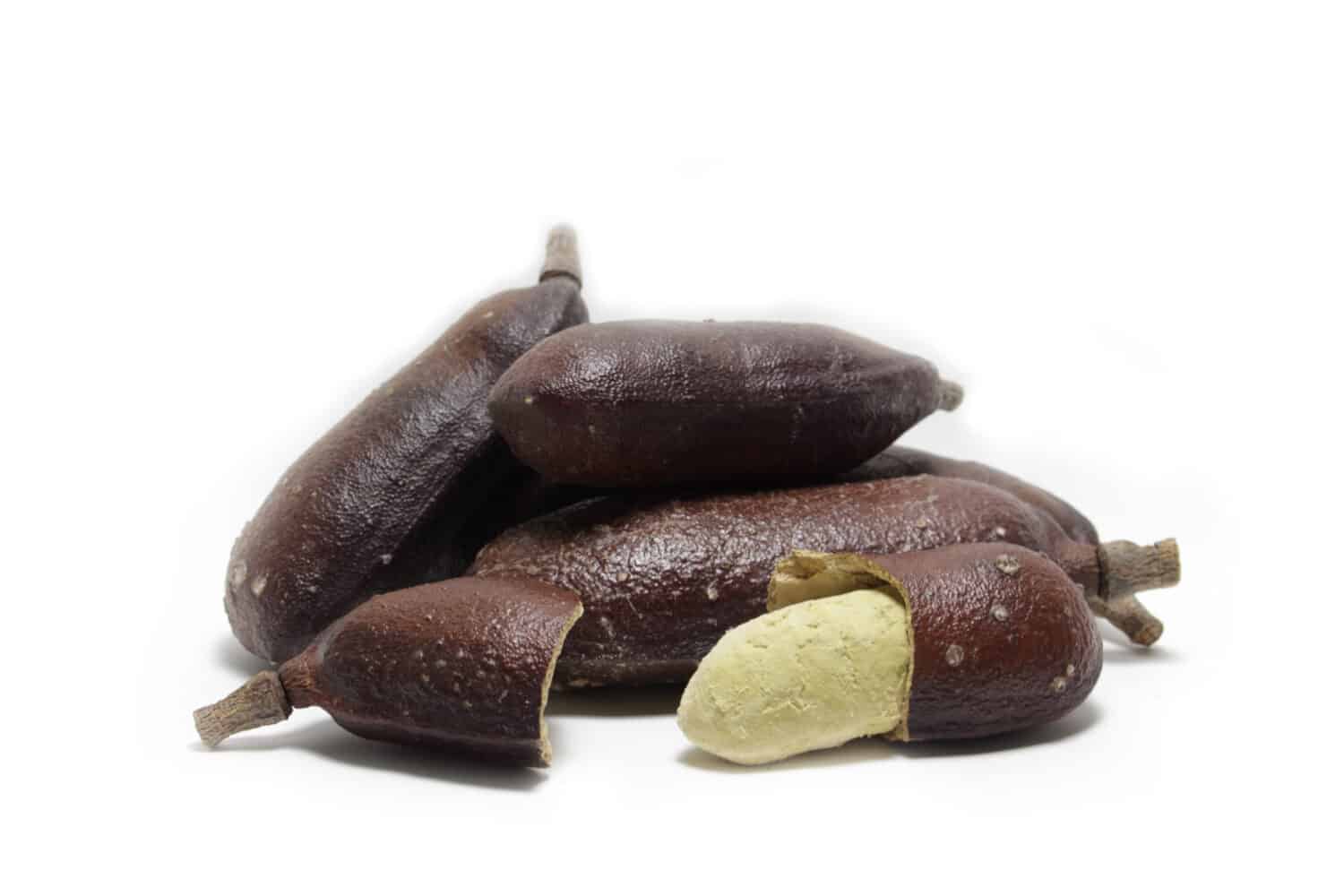
Another fruit that starts with the letter J is the jatoba.
©Felipe Hideki Imanisi/Shutterstock.com
Jatoba, also known as Brazilian cherry or Hymenaea courbaril, is a tropical fruit that originates from the Amazon rainforest and other parts of South America. The fruit is typically round or oval-shaped and has a hard, woody shell that encases the edible pulp.
The jatoba pulp has a distinctly unpleasant odor, but once you get over the smell, the taste is quite sweet. Although it is consumed raw, it is also dried and turned into a powder or into a drink called “atole”. When eating jatoba pulp, many add sugar to make it extra sweet.
It is commonly eaten fresh for its remarkable health benefits. It also has impressive anti-fungal properties and is widely used to treat eczema and psoriasis in herbal medicine practices. Furthermore, this fruit has a high concentration of starch and protein.
9. June Plum

Native to Southeast Asia and the Pacific Islands, the June plum is sweet and tangy in flavor.
©RoYam/Shutterstock.com
June plum, scientifically known as Spondias dulcis, is a tropical fruit native to Southeast Asia and the Pacific Islands. Also known as ambarella or golden apple, the June plum gets its name from its peak season of ripeness in June.
The fruit has a round shape and bright yellow or golden skin with a slightly waxy texture. When ripe, it has a juicy flesh that is mildly sweet and tangy. With a perfect blend of sweetness and tanginess, you will find its taste similar to a blend of mango and pineapple.
June plum is commonly consumed fresh, used in salads, or made into refreshing juices and chutneys. It is a good source of vitamins A and C and dietary fiber and is loved for its unique tropical flavor.
10. Junglesop
Junglesop, scientifically named Anonidium Mannii, is one of the biggest fruits on Earth, ranging from 11 to 33 pounds (5 kg to 15 kg) in weight. It has a leathery brown outer layer with a raised diamond shape patterned, aesthetically carved by mother nature. Inside, you’ll find soft yellow flesh with a sweet and tangy flavor. Many consider junglesop to be an acquired taste.
This fruit is also rich in vitamin A and possesses great medicinal properties.
11. Java Apple

A tropical fruit, the Java apple is rich in vitamins C and A.
©Photoongraphy/Shutterstock.com
The Java apple, also known as Syzygium samarangense, is a tropical fruit native to Southeast Asia. It has a unique bell-shaped appearance with smooth, waxy skin ranging in color from white and green to red and even black. The fruit has a crisp texture and a mildly sweet and refreshing flavor.
Java apples are high in vitamins C and A and can be a great source to boost your immunity and help reduce inflammation.
12. Jazz Apple
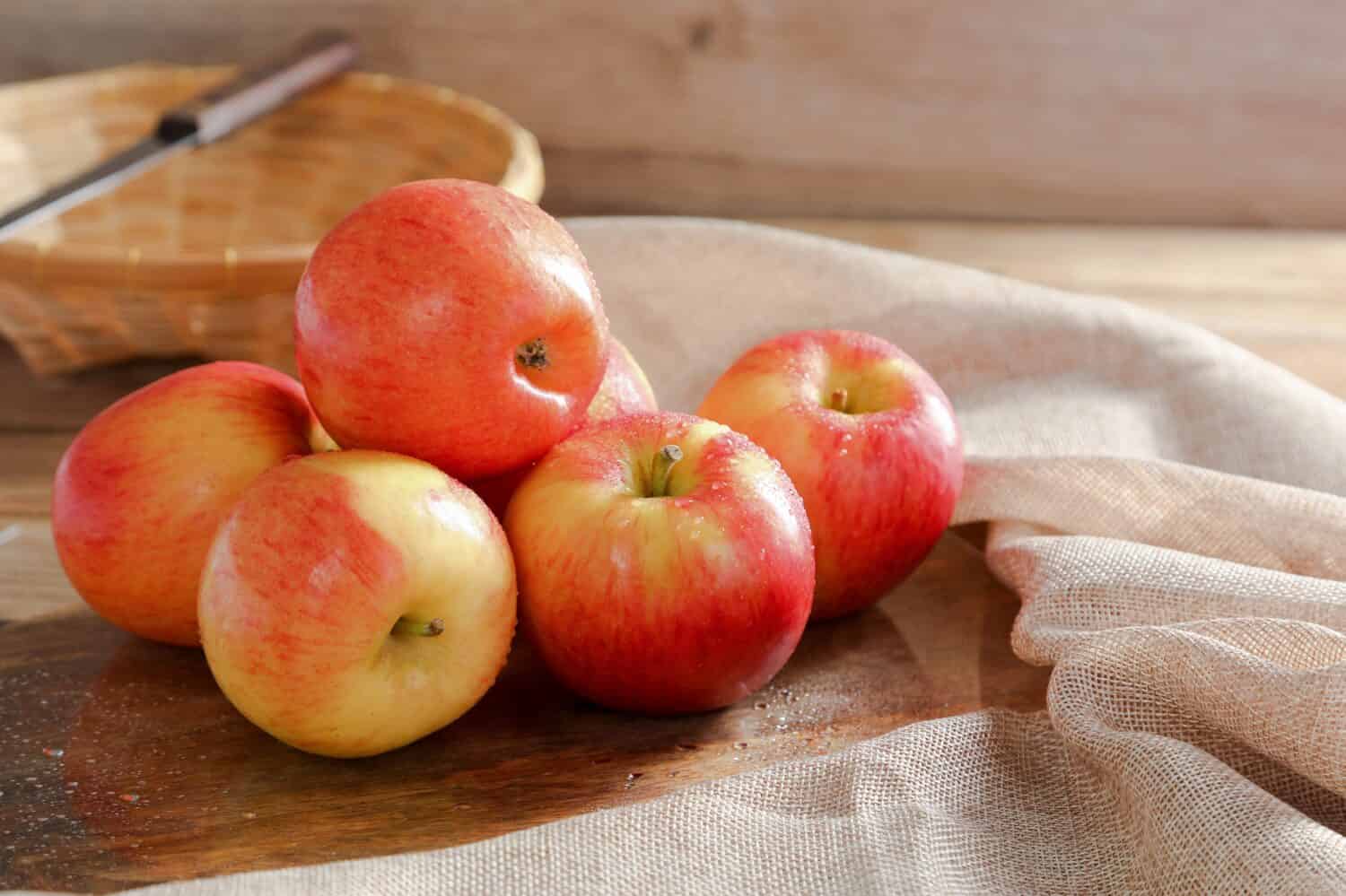
A popular type of apple is the Jazz apple.
©BirdShutterB/Shutterstock.com
Jazz apples are a popular variety of apples with a vibrant appearance and crisp texture. Developed in New Zealand, Jazz apples are a cross between the Royal Gala and Braeburn apple varieties. They have distinctive deep red skin with yellow-green undertones and sometimes exhibit subtle stripes.
You’ll find its flavor a combination of sweet and tangy. These apples also hold up well when baked, making them suitable for pies, tarts, and other desserts.
In terms of benefits, Jazz apples provide ample amounts of vitamin C to strengthen the immune system and reduce inflammation. It also is a good source of vitamins A, E, and K.
13. Johannisbeere
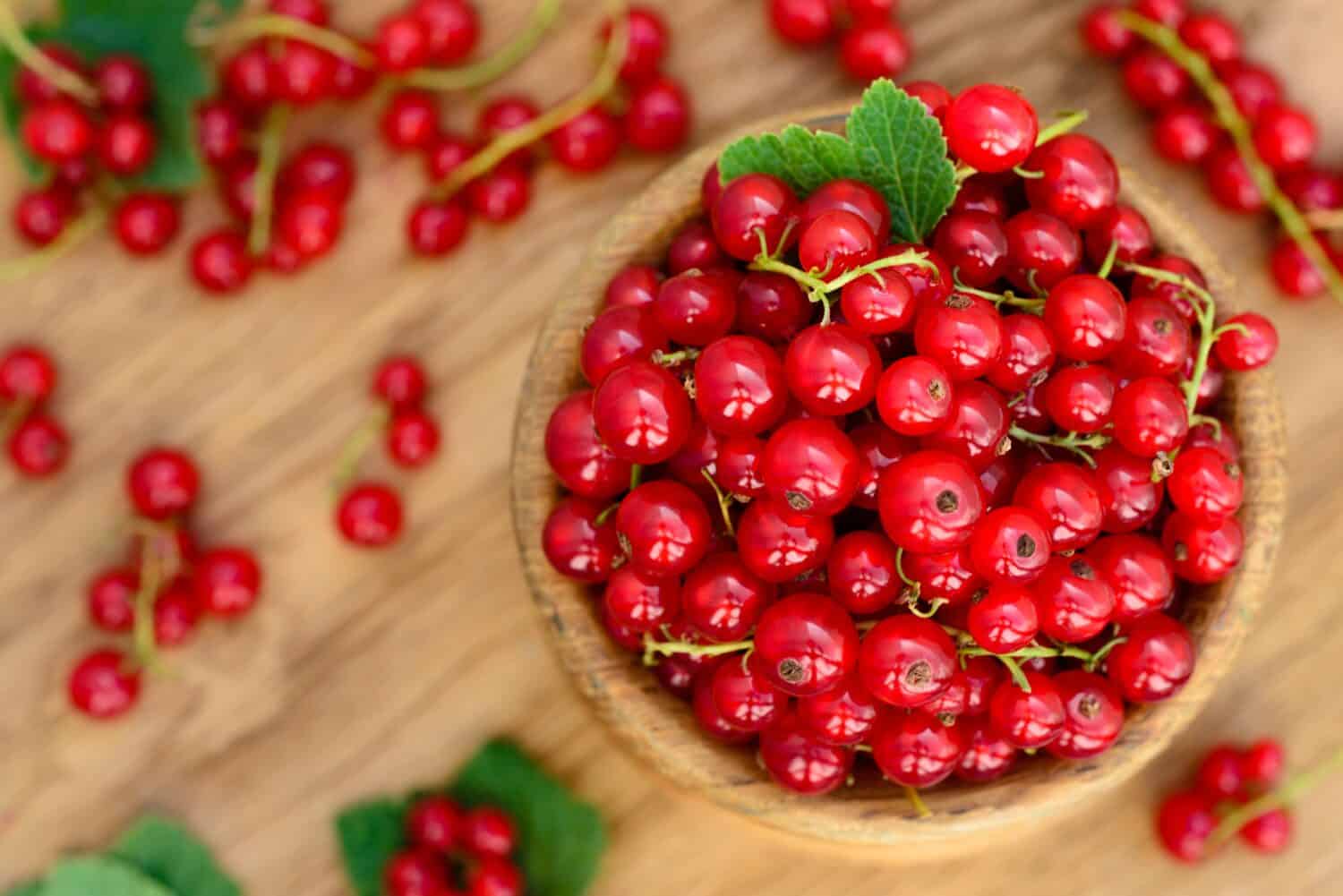
Also known as red currant, Johannisbeere is another fruit that starts with J.
©Tim UR/Shutterstock.com
Johannisbeere, commonly known as red currant, is a small, round berry that belongs to the Ribes genus. It is native to Europe and has a tart and tangy flavor. The scientific name for red currant is Ribes rubrum.
Red currants can be eaten in many ways. You can eat them fresh or in dried form. You can also make jam, jellies, or chutneys or use them in your recipes.
Red currant also offers significant health benefits. It is anti-inflammatory, can aid digestion, and supports your immune health. This fruit is a rich source of vitamin C.
14. Jostaberry

Jostaberry is a cross between a blackcurrant and a gooseberry.
©Monika_1/Shutterstock.com
Scientifically named Ribes × nidigrolaria, jostaberry is a cross-fruit bush that involved crossing three distinct species: the blackcurrant, the North American coastal black gooseberry, and the European gooseberry.
This fruit is nearly black in color and is edible in both raw and cooked forms. The berry tastes somewhere between a gooseberry and a blackcurrant. Just like blackcurrants, jostaberries freeze well, so they can be a great addition to a morning smoothie.
Jostaberries are rich in nutrition, filled with vitamin C and antioxidants. Interestingly, this fruit has anti-fungal properties as well.
Comprehensive List of All Fruits That Start With J
- Jaboticaba
- Jackfruit
- Jujube
- Juniper Berry
- Jambul
- Japanese Persimmon
- Jocote
- Jatoba
- June Plum
- Junglesop
- Java Apple
- Jazz Apple
- Johannisbeere
- Jostaberry
- Jamaican Cherry
- Japanese Raisin Tree
- Japanese Yuzu
- Jarilla
- Jarrah
- Jonagold Apple
- Jelly Palm
Summary of the Fruits That Start With J
| Fruit | Benefits |
|---|---|
| Jaboticaba | Rich in potassium, calcium, and vitamins A, C, and E |
| Jackfruit | High in fiber, protein, vitamins C and B, and potassium |
| Jujube | Nutrient-rich, especially in vitamin C, natural anti-aging, and immunity booster |
| Juniper Berry | High in antioxidants and anti-inflammatory properties |
| Jambul | Medicinal properties, rich in vitamins, minerals, and antioxidants |
| Japanese Persimmon | Good source of vitamins A and C, dietary fiber, potential heart health, and digestion benefits |
| Jocote | Rich in carotene, B-complex vitamins, vitamin C, and amino acids |
| Jatoba | Potential anti-fungal properties |
| June Plum | Good source of vitamins A and C, and dietary fiber |
| Junglesop | High in vitamin A |
| Java Apple | High in vitamin C and A, enhances immunity, and reduces inflammation |
| Jazz Apple | High in vitamin C, strengthens immune system, and reduces inflammation |
| Johannisbeere | Vitamin C, anti-inflammatory properties, and digestive support |
| Jostaberry | Rich in antioxidants and vitamin C, and anti-fungal properties |
Thank you for reading! Have some feedback for us? Contact the AZ Animals editorial team.







